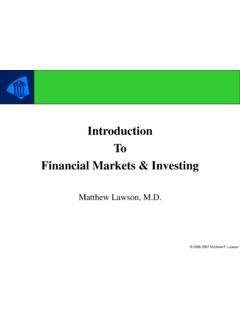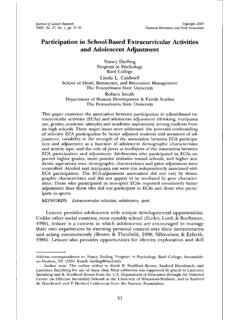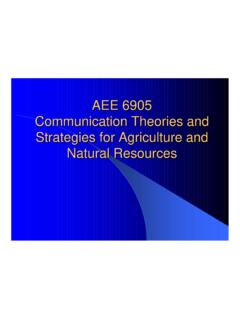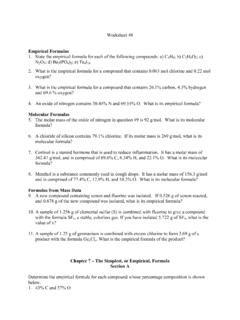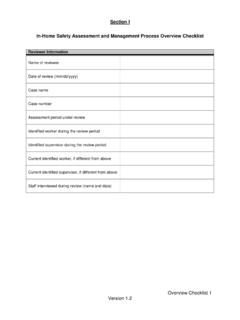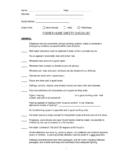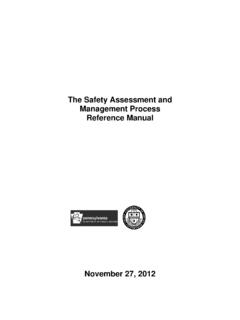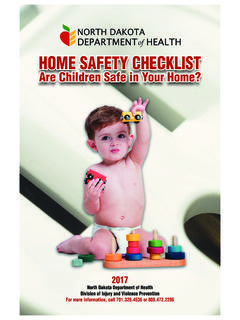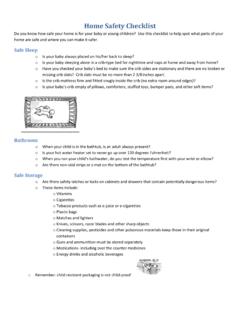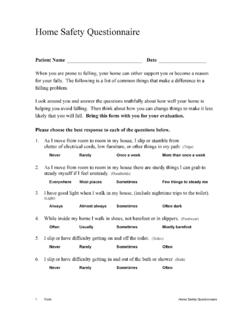Transcription of Promoting Safety and Function Through Home Assessments
1 ANEMAET and MOFFA-TROTTER26 TOPICS IN GERIATRIC REHABILITATION26 Top Geriatr Rehabil 1999;15(1):26 55 Promoting Safety and FunctionThrough home AssessmentsThis article is copyright 1999, Wendy Anemaet andMichelle Moffa-Trotter. It is printed with their article focuses on performing home Assessments . It presents the purposes of home Assessments , includingregulatory guideline adherence, fall reduction, Function improvement, and assistive device and adaptive equip-ment provision. Included is a review of the literature regarding the role of home Assessments in reducing falls andmaximizing Function . The Safe at home (Securing a Functional Environment with the Anemaet-Trotter HomeObservation and Modification Evaluation), the Functional Environment assessment (FEA), and the home SafetyChecklist provide several methods for performing effective home Assessments .
2 Key words: accidents, adaptiveequipment, assistive devices, environmental hazards, falls, home assessment , home evaluation, home safetyWendy K. Anemaet, MS, PT, GCS, ATCHome Physical TherapistMiami, FloridaMichelle E. Moffa-Trotter, PT, GCSHome Physical TherapistClearwater, FloridaINTRODUCTIONW orking with patients in their homes pro-vides the home care team unique opportuni-ties to design programs that meet the specificneeds of patients within their individual sur-roundings. home care providers strive tooptimize a patient s functional abilities notonly by modifying internal factors, such asstrength and balance, but also external fac-tors, such as living environments. Ideal homesituations promote independent Function anddo not restrict patients in their activities ofdaily living.
3 Numerous studies examiningfalls indicate home assessment is a majorcomponent of effective therapy 5 A home assessment examines as-pects of the living environment both insideand immediately outside the home , denotesareas that may potentially create problems ordangers for a patient, and distinguishesmodifications that make the living environ-ment safer and/or more Safety AND FUNCTIONVOL. 15, NO. 1/SEPTEMBER 199927 The Joint Commission on Accreditation ofHealthcare Organizations (Joint Commis-sion) recognizes the importance of homeassessments. Standard from the JointCommission s Comprehensive Accredita-tion Manual for home Care states: Theorganization also plans for physical Safety inthe patient s environment.
4 To reduce the riskof injuries or threats to life and health withinthe patient s environment to the extent pos-sible, the organization designs a method(s) toidentify risk. 6To perform complete home assessmentshome care providers must address four areasaccording to the Joint Commission:1. Fire Safety home care providers as-sess patient homes for fire hazards,instruct in fire prevention, and assistpatients in establishing fire Electrical Safety home care provid-ers instruct patients to recognize elec-trical hazards and correctly use electri-cal equipment in order to minimize riskof injuries an important componentof home Assessments and imperative ifhome care providers utilize electricalequipment during treatment Environmental and mobility Safety home care providers notify patients ofrisks associated with environmentalhazards, such as scatter rugs, poorlighting, and mobile Bathroom Safety Since bathroomspresent unique challenges for patients.
5 home care providers assess patientsafety and accessibility of these high-risk Assessments are necessary not onlybecause the Joint Commission requiresthem, but also for numerous other reasons. Aproper home environment decreases apatient s dependence at home and his or herreliance on others. Through appropriate liv-ing situations patients control their surround-ings, minimize injuries, and optimize theirfunctional capabilities. It is important thathome care providers perform home assess-ments that evaluate the degree of patientsafety and functional capabilities within liv-ing Safety OF THELIVING ENVIRONMENTOne in every three elderly persons living athome suffers a fall each Of these falls,50% result in injuries with 5% resulting infractures and another 5% resulting in othertypes of major ,8 Falls are a majorproblem for the elderly.
6 Risk factors forinjurious falls differ between disabled andindependent elderly home careproviders target their efforts toward fall re-duction via numerous patient specific inter-ventions, including reduction of environ-mental factors, in addition to intrin-sic factors, play an important role in fall Carter4 found 80% of the homes investi-gated had at least one hazard and 39% had fiveor more hazards even though 97% of the homedwellers felt their homes were fairly safe orvery safe. A study by Fleming and Pendergast5of 294 falls noted more than 50% of the fallsrelated to environmental factors, includingbedroom furniture, bedspreads, and floor fin-ishes. Further, Morfitt10 found that 53% ofelderly emergency department patients seenafter a fall attributed the fall to some environ-mental factor.
7 A recent study by Gill et al11found potentially serious environmental haz-ards widespread in the homes of elderly per-sons and, more important, many of these haz-ards were more common in the homes of frailANEMAET and MOFFA-TROTTER28 TOPICS IN GERIATRIC REHABILITATION elderly persons with disabilities, defined aspersons with self-reported deficits in activitiesof daily living or specific observed deficits onthe Tinetti Performance-Oriented relative importance of thorough homeassessments and modification of environ-mental hazards differs depending on variousfactors, including medical conditions andage. Northridge et al8 compared home safetyand falls of 325 elderly persons living athome that were divided into vigorous andfrail groups based on their scores on frailtyscales.
8 Although the study linked falls tohome hazards, the association was notstrong. However, vigorous older personsdemonstrated increased risks for falls wherehome hazards were present. Frail elderlypersons did not. Further, a study of 911 persons60 years of age or older found that environmen-tal hazard modifications had the greatest poten-tial for prevention among the young old andthose living in private These studiessuggest that interventions, including home as-sessments, should differ depending on themedical conditions of patients and their care professionals should target their fallprevention efforts Through environmentalmodification toward patients between the agesof 60 and 80 and for those who have fewmedical need for home Assessments and modi-fications may also differ depending on thepatient s fall history.
9 Two-thirds of olderpersons who fall will fall again within Studenski et al13 looked at the asso-ciation between the environment and recur-rent falls in a prospective cohort study of 306male veterans 70 years of age and screens determined risks for recur-rent falls and environmental hazards. Thestudy found recurrent fallers had more-threatening environments and that the envi-ronment was a significant predictor of recur-rent living environments affect fallrisk and because falls present such seriousconsequences for older adults, environmen-tal influences on falling warrant further re-view of the literature. However, determiningwhether reducing hazards in and aroundhomes conclusively result in lower inci-dences of falls is difficult at best.
10 Isolatingextrinsic factors such as scatter rugs, stairs,and flooring surfaces from intrinsic factorssuch as balance, strength, and reaction time isnot always randomized controlled study investi-gated the effects of modifying risk factors,including environmental hazards in commu-nity-dwelling persons who were at least 70years of Subjects in the experimentalgroup received appropriate interventions forpositive risk factors postural hypotension,multiple medication use, sedative use, trans-fer and gait impairments, range of motionand strength deficits, and environmental haz-ards. Results demonstrated that a multifacto-rial approach, including decreasing environ-mental hazards in older persons homes, ledto a significant reduction in the risk of , the amount of fall risk reductioneffected by minimizing hazards in andaround homes was et al utilized a multifacetedintervention that included walking, strengthand balance training, and home Safety im-provements with 1,323 community-dwellingpersons aged 65 and Findings sug-gested that health problems played a moreimportant role than environmental factors inthe more-serious and Beck16 undertook a study thatdemonstrated a more positive correlationPROMOTING Safety AND FUNCTIONVOL.

